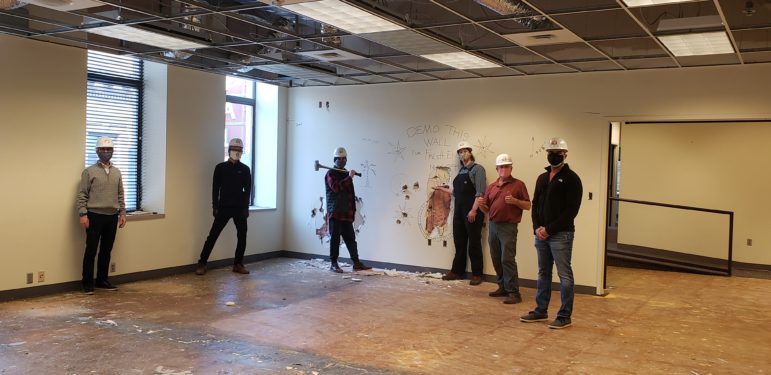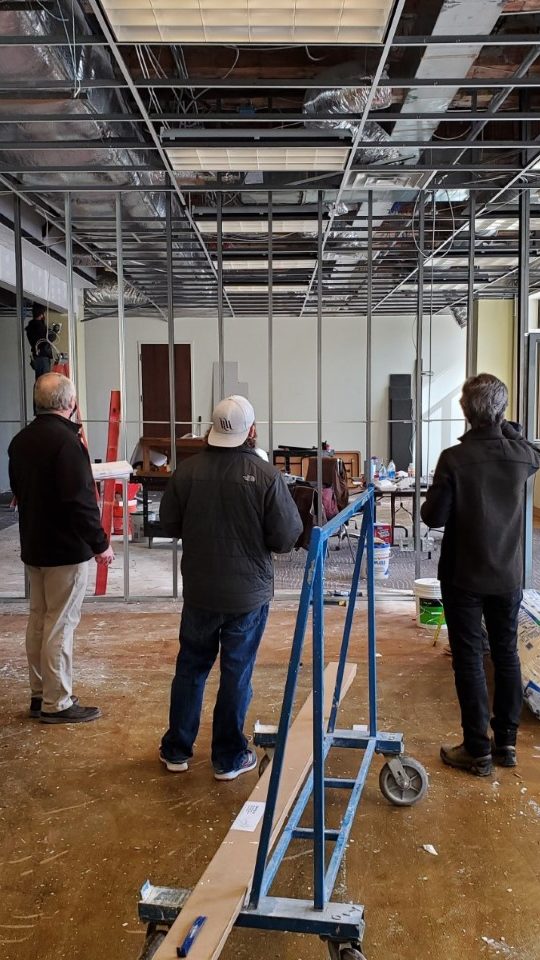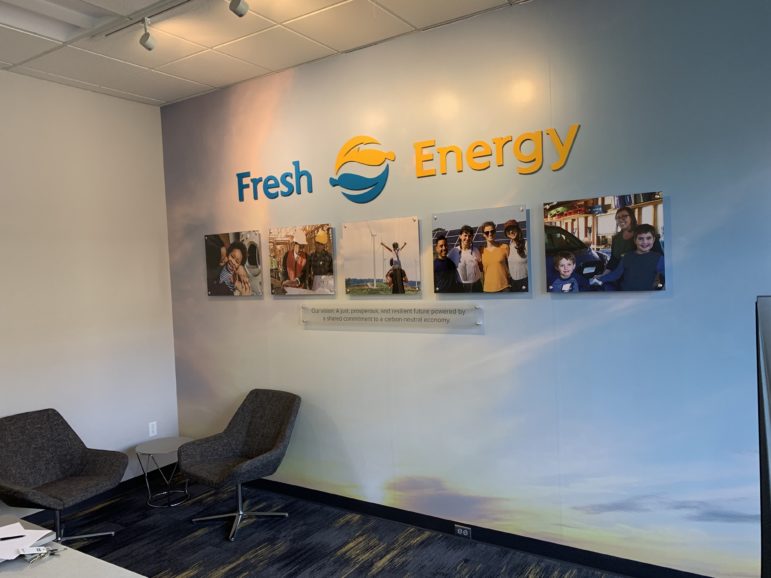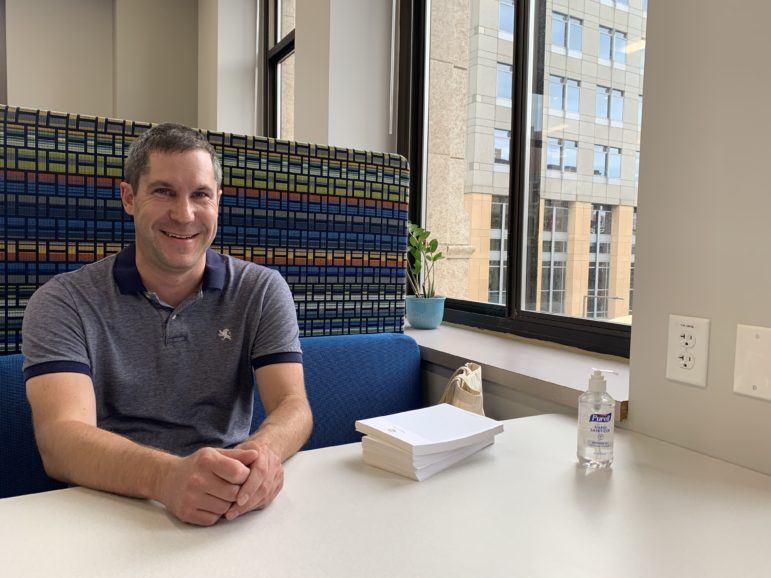
When Fresh Energy began nearly 30 years ago, the organization had two staff people and almost no one was talking about climate and carbon pollution. Over the decades, Fresh Energy has demonstrated the importance of our work and our staff has grown steadily—usually by one new position per year. However, more recently we have experienced larger bursts of growth as the Energy News Network has grown to a national independent news source and programs such as Energy Access and Equity have emerged as central aspects of our work.
By 2019 it was very clear that Fresh Energy was outgrowing its office space on the second floor of Saint Paul’s historic Hamm Building. In my interview for the Fresh Energy Operations Director job in May of that year, one of the interview questions was: “How would you feel about leading an office move and possible renovation project?” I thought to myself, “how hard could it be?” I was soon to find out.
Renovation planning in a pandemic

Fresh Energy evaluated multiple scenarios as we planned for our new office, working around other tenants in the Hamm Building, non-profit budgets, and a democratic philosophy based on collaboration, not status. With planning for a new strategic framework underway in 2020, it gave us even more reason to plan our space thoughtfully, reflecting our mission and values.
The office planning process came to an unexpected crossroad in March of 2020 when we made the decision to close our existing physical office and all staff went virtual to fight the spread of COVID-19. The pandemic forced me to revisit my assumptions about office space and culture. What would office life look like in a post-COVID-19 world? This question was constantly on my mind as I worked my way through a multitude of contract and budget negotiations, an intensive staff-input process on the space and the future of employee health, design proposals from architects, and vendor selection processes.
To further complicate matters, the complexity of designing a new office skyrocketed with added questions about building ventilation, the lack of vaccines (at the time), asymptomatic persons, negotiating and designing through Microsoft Teams messenger, and how a virus can spread. With all of this in mind, we continued the process knowing we were charting our course into the unknown territory of a post-pandemic office world.
By the time Fresh Energy announced its bold new strategic framework and direction in late 2020, those of us on the leadership team had made headway on the office space planning—which, in itself, is a bit of a miracle given the many challenges presented throughout 2020. Construction had begun on a new office space directly above our former Fresh Energy space. This new location, though just one floor higher, had a much larger footprint and significantly better natural light—two features that we knew were important to staff.
In our two-year journey through planning and renovation, Fresh Energy’s new space has evolved to be:
A space that welcomes:

We pulled employee voices into the design phase by seeking candid input on floorplan, furniture, and other accents. Employee comments coalesced around a warm and welcoming space that offers employees a daily choice between quiet and collaborative work areas. The process of co-designing with employees has continued and sub-groups are developing a room naming system, bringing the outdoors inside with vibrant plants, decorating our walls with art featuring a Minnesota artist, and establishing a “Welcome Team” for employees and board members to ensure the office is open to all.
A space that nurtures different ways of learning and working:
Engaging employees in the office design process gave me a better understanding of how individual workstyles vary from day-to-day, with staff conducting research, delivering public testimony written and orally, leading stakeholder conversations, writing complex policy, analyzing vast amounts of data, maintaining close relationships with donors, and so much more. Given this broad range of work, I knew it was imperative that Fresh Energy’s office have space to collaborate as a team, rooms to study, places to have closed-door meetings, video-conferencing capabilities to connect with partners in other states, and different spaces to sit and work while enjoying the sun or to have a break.
A space that adapts:
Throughout this process, I have also come to recognize that learning happens outside of the walls of an office. COVID-19 has led me to fully embrace that our lives outside of an office and Fresh Energy’s work are inseparable, and I am working toward a people-centered policy where each employee can bring their authentic selves to Fresh Energy and not be identified squarely with a traditional nine-to-five office schedule. To that end, we have encouraged staff to make home a place where work focus and collaboration can also happen, and we’ve provided financial assistance that encourages each employee to curate their home office into a space that works for them. Fresh Energy’s space is in-person, at home, and virtual. To further recognize that employee identities extend beyond title and job, the office will feature a community wall where we will post pictures of employees, their partners, families, friends, and more.
A space to grow our shared commitment:
Fresh Energy’s vision is for a just, prosperous, and resilient future powered by a shared commitment to a carbon-neutral economy. Our new office is an opportunity to develop a community that has a shared commitment for a clean energy future. Community-building is a process, but having a physical and virtual place to be together and collaborate is an important part of the growing team. When Fresh Energy’s renovation is complete, we will have a gathering place to comfortably host larger groups of employees, partners, and board members—as well as have virtual audio and video components built in for those who are unable to join us in person.
What’s next? A both-and future:
Throughout 15 months of virtual work, with employees scattered across Minnesota and out of state, our team has not missed a beat. We continued to drive key clean energy policies and priorities that align with Fresh Energy’s mission. This proved to me that work is less about where you are and more about what you do.
That said, it is undeniable that the COVID-19 pandemic has challenged our team’s human-to-human connection. While happy hours, wellness initiatives, and anniversary celebrations have gone virtual, I am confident these will be some of the first in-person activities to return when we open our new space. We are also looking forward to welcoming into our community new employees who joined us during the pandemic.

In June 2021, Fresh Energy’s new home in Suite 350 of the Historic Hamm building will be open for all vaccinated employees when they are ready to return. My goal is for our team to have this new, warm, welcoming, and co-created space outside of their homes to come together whether it is to focus, collaborate, host meetings, or just grab coffee.
Carefully stewarding the resources entrusted to us, Fresh Energy balanced cost and the desire to create an office that inspires and facilitates our staff’s ability to drive ambitious, equitable progress at the scale of the climate change problem. As we strive toward a healthy, just, carbon-neutral future in Minnesota and beyond, Fresh Energy will continue to expand and evolve. This office space will effectively accommodate that growth.
We are looking forward to a time when those who care about Fresh Energy’s work can come check out our new space. But, until then, we want you to know that from the art on the walls to the break room to the variety of gathering spaces and everywhere in between we have worked together to create a space that says, “Welcome to Fresh Energy!”

